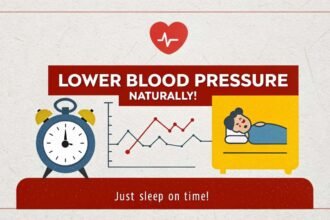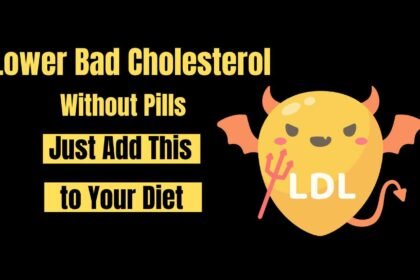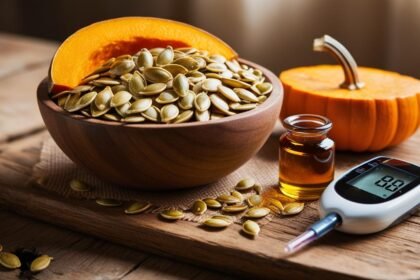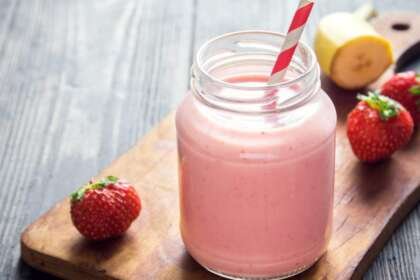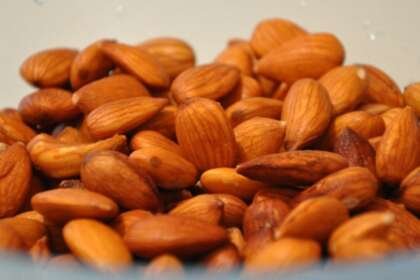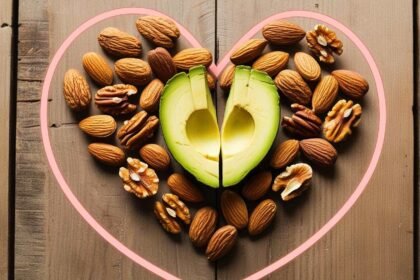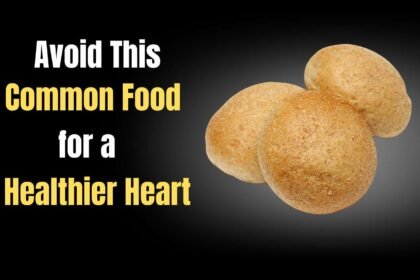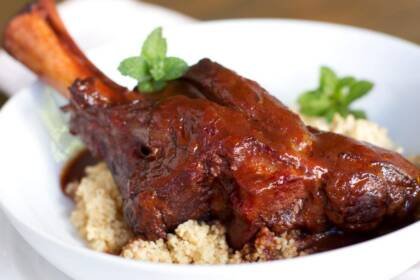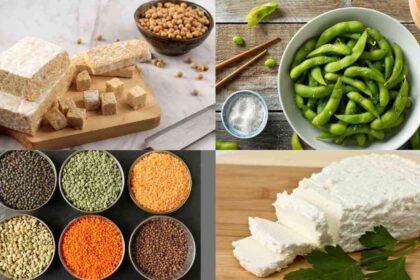Protein is an important nutrient that helps the body make enzymes and hormones, repair and build tissues, and stay healthy overall. (Source)
Although chickpeas are a well-known plant-based source of protein (they have about 15 grams of protein per cooked cup), there are other foods that are even higher in protein.
Adding a variety of these protein-rich foods to your diet can help your body work and give you more nutrients. Here are 10 best alternative that have more protein than chickpeas:
1. Lentils
There are a lot of protein-rich vegetables like lentils. One cooked cup of lentils has about 18 grams of protein. They also have a lot of fiber, iron, and folate, which makes them a healthy addition to meals.
There are different kinds of lentils, like green, red, and brown ones, and each has its own taste and texture.
They cook quickly and can be used in salads, soups, stews, or as a meat substitute in foods like veggie burgers and lentil bread.
Additional Health Benefits:
- Heart Health: Rich in fiber, which helps lower cholesterol levels and reduce the risk of heart disease.
- Blood Sugar Control: Low glycemic index, making them a great option for people with diabetes.
- Gut Health: High fiber content supports digestion and promotes a healthy gut microbiome.
- Rich in Iron & Folate: Essential for red blood cell production and preventing anemia.
2. Edamame
Young soybeans, or edamame, are a snack and starter food that are loved in many cultures. About 18.5 grams of protein can be found in a cup of cooked edamame.
Besides having a lot of protein, edamame also has important nutrients like fiber, vitamins, and minerals. (Source)
They taste great on their own with a little sea salt on top, or you can add them to soups, stir-fries, and grain bowls to make them more protein-packed.
Additional Health Benefits:
- Bone Health: High calcium and vitamin K content help maintain strong bones.
- Hormonal Balance: Contains phytoestrogens, which can be beneficial for women during menopause.
- Weight Management: Low in calories but high in protein and fiber, keeping you full longer.
- Heart Health: Contains heart-friendly omega-3 fatty acids and lowers LDL (bad) cholesterol.
3. Tempeh
Tempeh is an Indonesian food made from fermented soybeans. It’s a great plant-based source of protein because each cup has about 31 grams of protein.
The fermentation process makes tempeh firm and gives it a nutty taste. It also makes it easier to digest and absorb nutrients.
Tempeh can be chopped, marinated, and cooked in a number of different ways, such as by grilling, sautéing, or baking.
It can be used in a lot of different ways and tastes great in salads, sandwiches, stir-fries, and as a meat replacement in many recipes.
Additional Health Benefits:
- Gut Health: Fermentation enhances digestion and provides probiotics.
- Rich in B Vitamins: Supports energy production and brain health.
- Stronger Bones: High calcium content helps prevent osteoporosis.
- Reduces Inflammation: Contains antioxidants that help fight oxidative stress.
4. Seitan
Seitan, which is sometimes called wheat gluten, is a protein source that vegetarians and vegans like. There are about 21 grams of protein in a 3-ounce dose of seitan.
To make it, you wash wheat flour dough with water to get rid of the starch grains but keep the gluten. Seitan is a versatile meat substitute that can be used in stir-fries, sandwiches, and stews because it has a chewy texture and can take on different tastes.
But it’s important to know that people who are sensitive to gluten or have celiac disease should not eat seitan.
Additional Health Benefits:
- Muscle Building: High protein content supports muscle growth and repair.
- Low in Fat: Suitable for those looking to maintain a lean diet.
- Rich in Iron: Helps prevent anemia and supports oxygen transport in the body.
- Versatile Meat Substitute: A great alternative for those reducing meat consumption.
5. Greek Yogurt
Greek yogurt is a dairy product that is known for being thick and high in protein. A 7-ounce (200-gram) amount has about 20 grams of protein.
It also has a lot of calcium and probiotics, which are good for your bones and gut bacteria.
You can eat Greek yogurt by itself, mix it with nuts and veggies, or use it as the base for sauces and smoothies. If you want to avoid added sugars, choose plain, unsweetened versions.
Additional Health Benefits:
- Supports Digestion: Probiotics improve gut health and digestion.
- Bone Strength: High calcium content prevents osteoporosis.
- Boosts Metabolism: Protein helps maintain muscle mass and increase calorie burning.
- Enhances Immunity: Probiotics and nutrients like zinc help strengthen the immune system.
6. Cottage Cheese
Cottage cheese is made from fresh cheese curds and has about 24 grams of protein per cup.
Because it’s low in fat and carbs, it’s a popular choice for people who want to eat more protein without adding too many calories.
Cottage cheese can be eaten by itself, with fruit, or in many different recipes, such as soups, pancakes, and baked goods.
Additional Health Benefits:
- Weight Loss: High protein and low-calorie content aid in weight management.
- Muscle Recovery: Rich in casein protein, which is slowly digested, making it ideal for nighttime muscle recovery.
- Rich in Selenium: An antioxidant that supports thyroid function and immune health.
- Good for Diabetics: Low in carbs and doesn’t cause spikes in blood sugar.
7. Tuna
Tuna is a sea fish that is known for having a lot of protein. A 4.1-ounce (116-gram) can of tuna has about 22 grams of protein.
It also has a lot of omega-3 fatty acids, which are good for your heart. You can eat tuna fresh, fried or seared, or canned, which is great for quick meals. You can put tuna from a can in lasagna, soups, sandwiches, and casseroles.
When buying tuna in a can, it’s best to choose types that are packed in water to cut down on calories and fat.
Additional Health Benefits:
- Heart Health: Omega-3 fatty acids help reduce inflammation and lower heart disease risk.
- Brain Function: DHA and EPA (types of omega-3) support brain development and cognitive function.
- Improves Mood: Contains B vitamins and omega-3s, which help reduce anxiety and depression.
- Eye Health: Rich in vitamin A and omega-3s that support vision.
8. Salmon
Another food that is high in protein is salmon. A 3-ounce (85-gram) serving of salmon has about 21 grams of protein. It also has a lot of omega-3 fatty acids, vitamin D, and B vitamins.
Eating fish on a regular basis has been linked to a number of health benefits, such as better heart and brain health.
There are many ways to cook salmon, like grilling, baking, or poaching it. It goes well with many herbs, spices, and veggies.
Additional Health Benefits:
- Brain Health: Omega-3 fatty acids improve memory and reduce the risk of Alzheimer’s disease.
- Anti-Inflammatory Properties: Helps reduce chronic inflammation, which is linked to many diseases.
- Improves Skin Health: Rich in collagen-boosting nutrients that keep skin youthful.
- Supports Weight Loss: Protein-rich and contains healthy fats that help with appetite control.
9. Chicken Breast
About 26 grams of protein are in a 3-ounce (85-gram) amount of chicken breast, which is a lean meat. Because it’s low in fat and can be used in many ways, it’s a mainstay in many diets.
Grilling, baking, sautéing, or boiling are just a few of the ways that chicken breast can be cooked. It can also be seasoned to fit a wide range of cooking styles.
Adding chicken breast to your meals is a good way to get the nutrition you need every day.
Additional Health Benefits:
- Low in Fat: Helps maintain a lean body while providing essential nutrients.
- Boosts Immune System: Contains zinc and selenium, which support immunity.
- Enhances Metabolism: Rich in B vitamins, which help convert food into energy.
- Aids in Tissue Repair: Protein supports healing after injuries or surgeries.
10. Quinoa
As a whole grain, quinoa sticks out because it is high in protein. One cooked cup of quinoa has about 8 grams of protein.
Quinoa is a complete protein, which means it has all nine necessary amino acids that the body can’t make on its own. It has a slightly lower protein content per serving than chickpeas.
This makes quinoa a good food to eat if you are following a plant-based diet. As well as not having gluten, it has a lot of fiber, magnesium, and vitamins. You can serve quinoa as a side dish, mix it into soups, or use it as a salad base.
Additional Health Benefits:
- Complete Protein: Contains all nine essential amino acids, making it ideal for vegetarians and vegans.
- High in Antioxidants: Helps protect cells from oxidative damage.
- Gluten-Free: A great alternative for those with gluten intolerance.
- Good for Gut Health: High fiber content aids digestion and prevents constipation.


